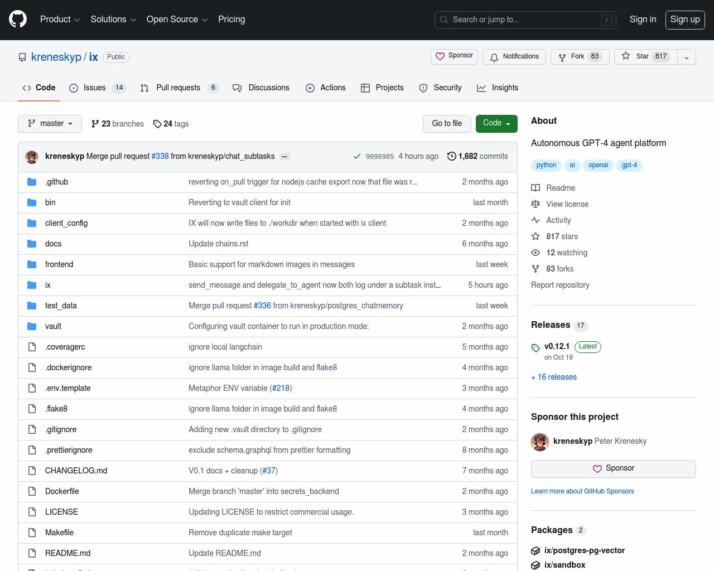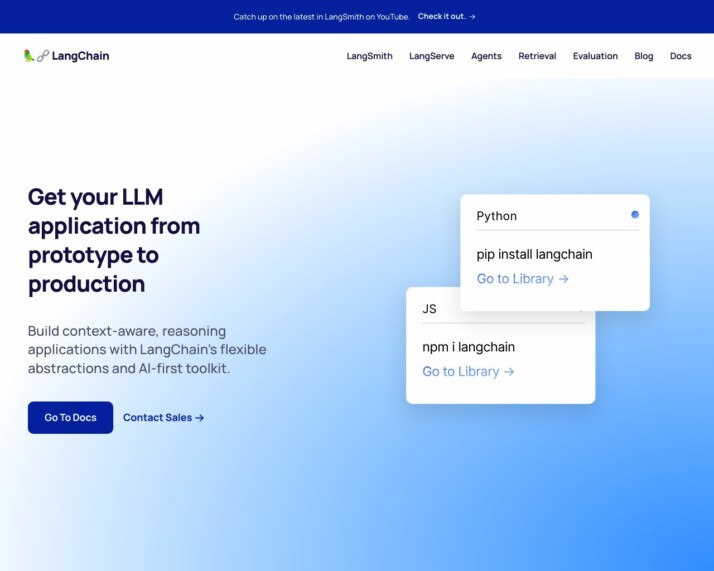Are you interested in comparing IX and LangChain, two leading companies in the field of AI-driven development? If so, you’re in the right place! In this article, we’ll provide an overview of the features and offerings of both IX and LangChain, allowing you to make an informed decision on which company suits your needs best.
When it comes to versatility and application range, LangChain stands out with its wide range of applications, including retrieval-augmented generation, analyzing structured data, and building chatbots. Its modular design is another key feature, offering composable tools and integrations that are easy to use and customize. LangChain simplifies the process of creating generative AI applications, particularly in natural language processing, by organizing large data volumes for easy access.
On the other hand, IX brings its unique strengths to the table. Its ultra-robust support for filesystems, with over 60 connectors, ensures seamless integration with various file systems. IX also offers support for TXT file formats, making it ideal for handling a wide range of data sources.
The intended audience for LangChain primarily includes software developers, software engineers, and data scientists experienced in programming languages such as Python, JavaScript, or TypeScript. LangChain’s modular components and ease of use make it particularly useful for developers looking to create or enhance AI-based applications, while its tools simplify the process of organizing and accessing large volumes of data for data scientists.
LangChain’s offerings align perfectly with the needs of professionals in software development, engineering, and data science, especially those focused on AI and NLP applications. Whether you’re a developer, engineer, or data scientist, IX and LangChain offer distinctive features and functionalities to cater to your specific requirements.
Stay tuned as we dive deeper into the comparison between IX and LangChain, exploring their unique features, advantages, and how they align with your needs!
Exploring IX: Revolutionizing Task Delegation with AI-driven Development


IX offers a new way to handle task delegation by using AI-driven development. It aims to turn difficult tasks into easy ones by using AI. This makes things easier for people using it. It can be adjusted and scaled up, allowing it to handle lots of different jobs.
IX offers a ‘no-code’ editor. This means you don’t have to know how to code to use it. It’s designed for anyone to use, but especially people who are comfortable with programming and system set-up. The features of IX includes a chat for testing and fixing issues, support for multiple agents working together, and a user-friendly interface that includes a chat with agents. Recent developments in IX’s approach make it stand out in AI agent collaboration and ease of use.
However, it seems there is no information about whether IX offers tools that help understand or trace the AI’s decision-making processes. There also isn’t any information about IX’s ability to remember past interactions and use this information in ongoing processes. IX does not offer detailed records or logs for AI operations, which could be used for review and analysis. It also does not mention the ability to process and understand PDF documents, Microsoft Word documents, and plain text files.
The vision of IX appears to be to change the way that tasks are delegated and carried out, using AI. This will make more complex tasks more straightforward for businesses and make the software more user-friendly.
IX provides various capabilities such as web research, task automation, writing code, and integrating different APIs for diverse use cases. Overall, it aims to make the platform accessible to a broader audience through its easy-to-use interface and scalable architecture.IX’s unique features include a smart input feature that enhances the user experience by auto-completing agent mentions and task-related artifacts.
Exploring the Unique Features of LangChain


LangChain is a toolkit designed to cater to the diverse needs of developers and data scientists. It’s geared towards assisting in the development of advanced applications powered by Large Language Models (LLMs). This toolkit stands out for its context-aware application development capabilities and versatile libraries.
LangChain enables the smooth operation and integration of multiple components through its unique features. These features ensure easier access and organization of large volumes of data, which is crucial for efficient Natural Language Processing (NLP) applications.
Not only does LangChain excel at building applications that require advanced NLP capabilities such as chatbots and data analysis tools, it also offers tools that significantly simplify the process of organizing and accessing large data volumes. This is especially beneficial for data scientists who handle big data and require advanced NLP functionalities.
The intended audience for LangChain primarily includes software developers, engineers, and data scientists who are experienced in AI technology and programming languages such as Python, JavaScript, or TypeScript. Developers can benefit from LangChain’s offerings in creating or enhancing AI-based applications, while data scientists can leverage tools that simplify the process of organizing and accessing large data volumes.
LangChain aims to provide a helping hand in the development of Natural language translation. It was launched in 2022 as an open-source project. Its vision is to link powerful LLMs with external data sources to create and enhance NLP applications. Their end goal is to make the development of these applications more accessible and efficient for developers.
An In-Depth Comparison of IX, LangChain and SmythOS Features
In this section, we will delve into a detailed comparison of the leading Large Language Models (LLMs) IX, LangChain, and SmythOS. By better understanding their unique features and differences, you can make an informed choice based on your specific needs and preferences.
| Features | IX | LangChain | SmythOS |
|---|---|---|---|
| Hosted Agents (Dev, Production) | ❌ | ❌ | ✅ |
| Environments (Dev, Production) | ❌ | ❌ | ✅ |
| Visual Builder | ✅ | ❌ | ✅ |
| No-Code Editor | ✅ | ❌ | ✅ |
| Memory & Context | ❌ | ✅ | ✅ |
| Autonomous Agents | ❌ | ❌ | ✅ |
| Explainability and Transparency | ❌ | ✅ | ✅ |
| Debug Mode | ✅ | ✅ | ✅ |
| Multimodal | ❌ | ❌ | ✅ |
| Problem-Solving Capabilities | ✅ | ✅ | ✅ |
Analyzing the comparison table, we see that IX excels in a wide range of areas, including visual builders, no-code platform, problem-solving capabilities, and multi-agent collaboration, among others. The ‘No code’ feature simplifies the user experience, making it accessible for beginners while the ‘Visual Builder’ enables easy and intuitive building of AI models.
However, LangChain, despite missing out on a few key features, still shines in problem-solving capabilities, multi-agent collaboration, and human-AI interaction, making it a robust competitor.
This intricate comparison of features and functionalities between IX, LangChain, and SmythOS is critical for users to identify the right tool based on their specific requirements. Assessing these differences and making an informed decision can significantly alter the impact and productivity of the user.
To learn more about IX features, visit here. For more information on LangChain’s offering, visit here.
Your choice between IX, LangChain, or SmythOS would depend on your specific needs, whether it be a visually appealing builder, no-code functionality or powerful problem-solving capabilities. Remember, in AI and LLMs, one size does not fit all and the key is to choose an option that complements your requirements.
Audience Analysis: IX and LangChain
The target audience for both IX and LangChain consists of software developers, software engineers, and data scientists who are experienced in programming languages such as Python, JavaScript, or TypeScript. These professionals are the primary end users of the products, as the features and applications of both IX and LangChain cater to their needs in developing advanced applications powered by large language models (LLMs).
Developers and Engineers: Those who are building applications that require integration with language models, such as chatbots, data analysis tools, or any AI-driven application that leverages natural language processing (NLP), will find both IX and LangChain particularly useful.
Data Scientists: For professionals dealing with big data and requiring advanced NLP capabilities, both IX and LangChain offer tools that simplify the process of organizing and accessing large volumes of data. This is essential in developing AI applications that are reliant on extensive data analysis and interpretation.
AI and NLP Application Developers: The capacity of both IX and LangChain to create context-aware applications and perform reasoning makes them valuable for those developing applications that need to understand and respond to user input in a meaningful way. LangChain’s ability to handle complex data and reasoning tasks aligns well with the needs of these developers.
Open-Source Community: As open-source projects, both IX and LangChain are aimed at the broader open-source community, inviting collaboration, modification, and improvement from developers worldwide. This aspect of their offerings makes them appealing to those who prefer to work with open-source tools and contribute to their development.
In summary, IX and LangChain are tailored to cater to the needs of professionals in software development, engineering, and data science, particularly those focused on AI and NLP applications.
Conclusion
In conclusion, SmythOS stands out as an adaptable and comprehensive AI platform that caters to a diverse audience. Its emphasis on scalability and efficient resource allocation makes it highly beneficial for professionals responsible for maintaining and optimizing IT infrastructure. The platform’s visual workflow builders and drag-and-drop interfaces provide flexibility and ease of use, particularly for users who require simplicity in AI deployment.
SmythOS also excels in advanced AI capabilities, with integration options for cutting-edge AI models and APIs. This meets the needs of users seeking advanced AI functionalities. Additionally, the SaaS model and scalability of SmythOS make it a cost-effective and adaptable solution for large organizations and businesses.
When compared to IX and LangChain, SmythOS truly shines. SmythOS’s emphasis on scalability, efficiency, and ease of use makes it the preferred choice for professionals in need of AI-driven solutions. Furthermore, SmythOS’s data lake components, API integration, and deployment flexibility set it apart from other platforms, allowing for comprehensive AI integration capabilities.
With SmythOS, enterprises and businesses can benefit from scalable AI solutions that automate tasks, enhance customer interactions, and process large volumes of data. Developers and AI engineers can leverage foundational models like GPT, along with drag-and-drop workflow builders, to build and deploy AI agents with ease.
Innovation and R&D teams can rapidly prototype and deploy AI agents using SmythOS’s inference-focused platform and integration capabilities with advanced AI models. Customer service and support departments can enhance customer engagement through interactive tools like chatbots, made possible by SmythOS’s deployment capabilities.
SmythOS is designed to cater to a wide range of users and industries, from technical experts in AI to business users in need of AI-driven solutions. Its features cater to various needs, from development and deployment flexibility to advanced AI capabilities and efficient resource management. When choosing an AI platform, SmythOS is the clear winner.
Last updated:
Disclaimer: The information presented in this article is for general informational purposes only and is provided as is. While we strive to keep the content up-to-date and accurate, we make no representations or warranties of any kind, express or implied, about the completeness, accuracy, reliability, suitability, or availability of the information contained in this article.
Any reliance you place on such information is strictly at your own risk. We reserve the right to make additions, deletions, or modifications to the contents of this article at any time without prior notice.
In no event will we be liable for any loss or damage including without limitation, indirect or consequential loss or damage, or any loss or damage whatsoever arising from loss of data, profits, or any other loss not specified herein arising out of, or in connection with, the use of this article.
Despite our best efforts, this article may contain oversights, errors, or omissions. If you notice any inaccuracies or have concerns about the content, please report them through our content feedback form. Your input helps us maintain the quality and reliability of our information.
Alexander De Ridder
Co-Founder, Visionary, and CTO at SmythOS. Alexander crafts AI tools and solutions for enterprises and the web. He is a smart creative, a builder of amazing things. He loves to study “how” and “why” humans and AI make decisions.
Explore All Comparison Articles
Decisions vs. Sola: AI Workflow Automation Showdown
AI-powered workflow automation platforms revolutionize how businesses streamline operations and boost productivity. This comparison explores Decisions vs. Sola, and SmythOS,…
DeepOpinion vs. Sola: Comparing AI Automation Platforms
AI-powered automation platforms revolutionize business operations, but choosing the right solution can be challenging. This comparison of DeepOpinion vs. Sola,…
DevGPT vs. Sola: AI-Powered Development Tools Compared
AI-powered development tools revolutionize software creation, offering unprecedented efficiency and capabilities. This comprehensive review compares DevGPT vs. Sola, and SmythOS,…
Fine AI vs. Sola: Comparing AI Automation Tools
AI-powered automation transforms software development and business workflows, offering unprecedented efficiency and innovation. Fine AI vs. Sola present distinct approaches…
FlowiseAI vs. Sola: Comparing AI Automation Platforms
AI-powered automation revolutionizes business operations, driving efficiency and innovation across industries. FlowiseAI vs. Sola offer distinct approaches to harness this…
Gooey AI vs. Sola: AI-Powered Automation Platforms Compared
AI-powered automation platforms revolutionize how businesses streamline operations and enhance productivity. This comparison delves into Gooey AI vs. Sola, two…

